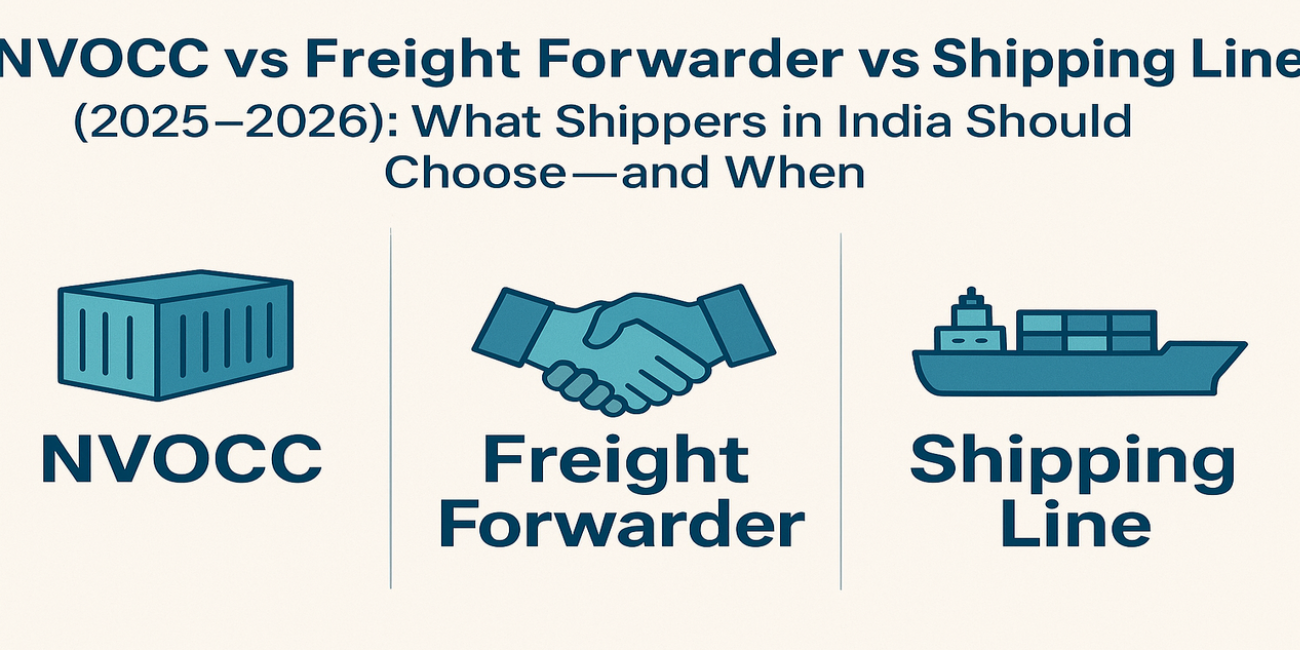


Picking between an NVOCC, a freight forwarder, and a shipping line shouldn’t feel like decoding maritime law. Here’s the clean truth: NVOCCs act as carriers and issue House Bills of Lading (HBLs), freight forwarders orchestrate end-to-end logistics and compliance, and shipping lines (VOCCs) operate the ships. In 2025–2026, with alliance shake-ups and India’s shipbuilding momentum, the choice you make shifts your rate, reliability, and risk. This guide shows exactly who to use, when, and why, with India-specific notes to keep paperwork tight.
A common carrier that issues its own HBL and doesn’t operate vessels. In its relationship with the vessel operator, the NVOCC is treated as the shipper—giving it room to blend capacity across carriers and protect your schedule under one HBL.
Provides carriage arrangement plus value-added services: consolidation, storage, handling, packing, distribution, documentation, insurance placement, and compliance advisory—structured globally by FIATA Model Rules. Think: one coordinator for multimodal complexity.
Operates the ships, publishes schedules, manages networks/alliances, and issues Master Bills of Lading (MBL). The Maersk–Hapag-Lloyd “Gemini Cooperation” starts 1 February 2025, with a phased network through mid-2025, shaping service design into 2026.
| Shipment profile | Pick | Why |
| SME LCL with rollover risk | NVOCC or a forwarder leveraging strong NVOCCs | HBL control + consolidation options reduce rollovers and rebooking pain. |
| Predictable FCL on stable lanes | Direct with Shipping Line (VOCC) + forwarder for docs | Contracted allocation and predictable free-time; keep forwarder for customs/inland. |
| Time-sensitive lanes with schedule variability | NVOCC | Ability to shift carriers/routes under one HBL protects transit time. |
| Complex door-to-door / multimodal | Freight Forwarder (FIATA-aligned) + NVOCC/VOCC | One brain for permits/compliance; blended capacity underneath. |
| ODC / heavy-lift | Forwarder with project cargo desk (plus NVOCC/VOCC as needed) | Permits, escorts, engineered lashing, special trailers/cranes—beyond standard freight. (Context from your ODC article.) |
In India, much door-to-door ocean logistics sits under the Multimodal Transport Operator (MTO) regime. The Multimodal Transportation of Goods Act, 1993 and DG Shipping prescriptions define the Multimodal Transport Document (MTD) and registration/renewal. Exporters should align BLs/MTDs, insurance, and door terms to avoid claims friction.
Practical takeaway: If your scope is truly multimodal, structure your contract documents (HBL/MBL/MTD), insurance clauses, and delivery obligations to fit MTO requirements before cargo moves.
1) Is an NVOCC legally a carrier?
Yes. An NVOCC is a common carrier that issues its own HBL and does not operate vessels; toward the VOCC, it is the shipper.
2) Can a freight forwarder issue a bill of lading?
A forwarder typically arranges carriage on a VOCC’s MBL or an NVOCC’s HBL, while handling documentation, consolidation, customs, insurance, and advisory under FIATA-aligned terms.
3) When should I go direct to a shipping line?
When you have predictable FCL volumes on stable strings and want contract allocation and consistent free-time—still with a forwarder/NVOCC supporting inland and compliance. Re-check 2025–2026 service changes first.
4) Does India’s MTO regime affect my choice?
Yes. Align MTD/BL strategy, insurance, and door clauses with the Multimodal Transportation of Goods Act and DG Shipping procedures to reduce claim and liability friction.

Your Global Trade Navigator, Delivering End-to-End Excellence and Unlocking New Opportunities in Every Link of Your Supply Chain.
Get In Touch
Explore our expert guide on Full Container Load (FCL) Shipping, covering benefits, processes, and tips to optimize your shipping experience efficiently.
Learn More FCL Shipping
SJ Logistics specializes in the global transportation of high-value, oversized cargo, ensuring safe and efficient delivery for your most complex project logistics needs.
Learn More Project Cargo
Discover tailored warehousing solutions at SJ Logistics, designed for efficiency and strategic storage. Optimize your supply chain with our innovative services today!
Learn More Warehousing
Discover comprehensive NVOCC solutions that streamline your logistics operations, enhance efficiency, and ensure seamless cargo management for your business needs.
Learn More NVOCC
Discover reliable inland transportation solutions that streamline your domestic logistics, ensuring timely and efficient delivery across the country.
Learn More Inland Transportation
Experience unparalleled convenience with our door delivery solutions, ensuring your packages arrive safely and promptly right at your doorstep. Discover more today!
Learn More Door Delivery
Experience seamless customs clearance with SJ Logistics. Our expert-led solutions ensure precision and efficiency, streamlining your import and export processes.
Learn More CHA
Experience unparalleled speed and reliability with our air freight services, ensuring your cargo reaches its destination swiftly and safely, no matter the distance.
Learn More Air Freight
Unlock the benefits of LCL shipping with our tailored solutions. Enjoy flexibility, cost savings, and strategic support designed for SMEs to thrive in global trade.
Learn More LCL Shipping